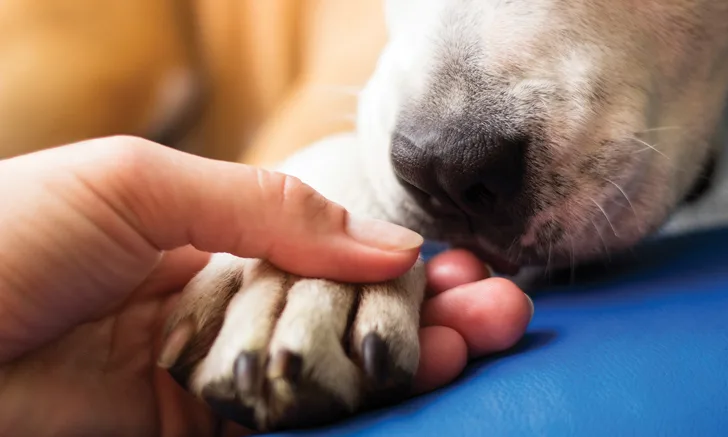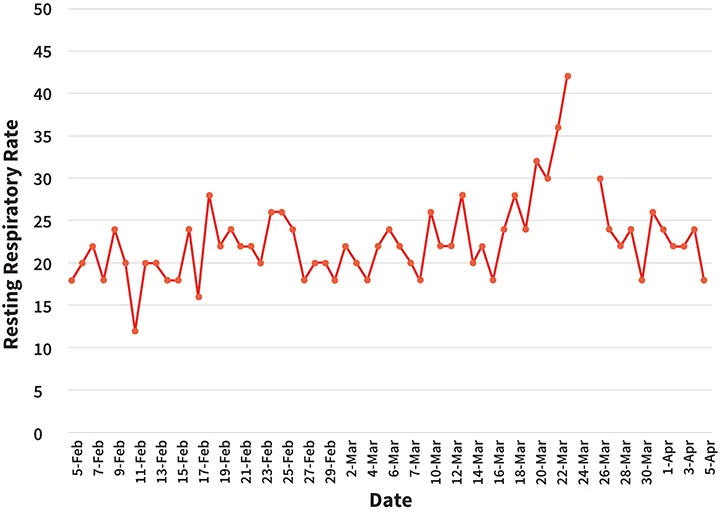Home Respiratory Rate Monitoring in Dogs & Cats
Brian A. Scansen, DVM, MS, DACVIM (Cardiology), Colorado State University

Resting respiratory rate (RRR) is the rate of breathing when a patient is calm but awake; sleeping respiratory rate (SRR) is the breathing rate when a patient is asleep. The most accurate rates are obtained in the patient’s home environment. Respiratory rates measured at the veterinary practice are also of value but are more likely to be increased because of stress or recent activity, complicating interpretation.
Pet owners can be trained to measure, record, and track their pet’s RRR and SRR at home to collect data that the veterinary team can use to assess cardiopulmonary status. Increased RRR and SRR may indicate early decompensation and the need for veterinary care before the next scheduled appointment. Early intervention (ie, before respiratory distress occurs) can help avoid costly hospitalization or death.
Several studies have demonstrated a correlation between increased RRR or SRR and congestive heart failure (CHF). A 2010 study that evaluated dogs with heart disease of varying severity found that in-hospital respiratory rates greater than 41 breaths/min were predictive of CHF.1 A subsequent study that investigated the ability of different parameters (eg, echocardiographic measurements, cardiac biomarkers, physical examination findings) to predict resolution of CHF in the first 2 weeks after diagnosis confirmed the value of home monitoring.2 Of the parameters studied, only home respiratory rates measured by owners the day before a pet’s follow-up examination were predictive of the presence or absence of radiographic CHF. A home RRR or SRR greater than 40 breaths/min was shown to be highly sensitive in predicting CHF.
RRR & SRR Reference Ranges
In dogs, normal values for home SRR range from 6 to 25 breaths/min.3 A 2012 study on home SRR in healthy dogs reported an average of 14 breaths/min with an upper limit of 25 breaths/min.3 A later study found that home SRR for dogs with stable heart disease averaged 16 breaths/min and was nearly always fewer than 25 breaths/min. Dogs with increased left atrial size had a slightly faster home SRR than dogs with only mild or no left atrial enlargement.4 Home RRR ranges were often slightly higher than home SRR ranges, with normal values in 14 dogs reported as 14 to 35 breaths/min, with a mean of 19 breaths/min.3 In the study of dogs with stable heart disease, home RRR averaged 21 breaths/min, with 7% of dogs exceeding 30 breaths/min.4
Reference RRR and SRR values in cats range from 8 to 35 breaths/min.5 Home SRR and RRR were evaluated in 59 echocardiographically normal, 28 apparently healthy, and 54 subclinical heart disease cats; RRR and SRR were similar in sick and healthy cats, with a median RRR of 27 breaths/min and SRR of 21 breaths/min.5 Approximately 10% of these cats had occasional-to-frequent SRR measurements of 30 breaths/min. Cats with an enlarged left atrium had a higher SRR.5
Based on these studies, lower limits for SRR and RRR appear to be clinically unimportant. The upper limit of normal for SRR is approximately 25 breaths/min in dogs and 30 to 35 breaths/min in cats. RRR upper limits are slightly higher.
Consider This …
A dog has just been diagnosed with degenerative mitral valve disease; the veterinarian recommends home monitoring of SRR as part of the treatment plan. The veterinary nurse shows the owners how to measure the dog’s respiratory rate and asks them to practice monitoring SRR at home on a daily basis for the next week. At the end of the week, the nurse calls the owners to inquire about the dog’s health and to obtain monitoring results. Based on the data, the veterinarian establishes a baseline rate of 14 to 20 breaths/min and creates guidelines for ongoing monitoring, including when to call the practice (eg, if SRR is >24-28 breaths/min for 2 consecutive days).
Owner Instruction
Owners should be instructed to measure either RRR or SRR—whichever value is easiest for them to obtain consistently—although SRR is preferred and appears less variable.4 Typically, only brief instruction is required for owners to become proficient in obtaining accurate measurements. Online videos that demonstrate measurement of RRR and SRR may provide further instruction.
Instruction should include what constitutes a breath (ie, one full cycle of chest movement in and out) and how long to count (ie, typically 30 seconds). The number of breaths counted in 30 seconds is then doubled to determine the rate per minute. RRR and SRR should be obtained with the patient in lateral or sternal recumbency. RRR should be measured only when the patient is calm and has not exercised in the past 30 minutes. For SRR, the patient should be restful or have been asleep for at least 15 minutes but not in active sleep with paddling or twitching. Owners should be reminded not to count RRR if the dog is panting.
RRR and SRR should be recorded on a daily basis or at least once or twice per week to identify any trends in rate; measurement should be obtained at the same time each day. Typically, measurements obtained during the first week are used to define a baseline as long as the animal is not showing clinical signs. Many apps are available for recording values (see Apps for Recording RRR & SRR). Biometric monitors that attach to a pet’s collar are also available and can provide daily SRR measurements taken at night when the pet is not moving. SRR, along with heart rate, sleep duration and quality, and activity level, are stored in a software program that provides graphical representations of these values over time. These monitors are fairly new in veterinary medicine, and publications establishing accuracy are limited; however, a recent abstract found greater than 86% accuracy between a monitor-measured respiratory rate and a manually counted rate.6
Apps for Recording RRR & SRR
Smartphones can make it easy for owners to track a pet’s RRR and SRR. Many of these apps are free and vary in complexity. For example, some provide a built-in timer that allows the user to specify a timeframe (eg, 30 seconds). The app then notifies the user via a sound effect to stop counting breaths when the time has elapsed. Other apps allow the user to tap the screen to record each breath, and the app automatically stops when it reaches a preset time. Data from the apps may be submitted directly to the veterinarian.
Owners should be advised that a value above the reference limit or with a deviation of at least 25% from their pet’s baseline might be suggestive of decompensation and indicate the need for prompt veterinary care. False-positive measurements can occur (eg, if panting is incidentally counted as the RRR, if the patient has a restless sleep episode, if the patient was incorrectly thought to be asleep). Confirming an increase in RRR or SRR over 2 to 3 recording periods should improve the validity of readings. Consistent recordings greater than 30 breaths/min in a dog or greater than 35 breaths/min in a cat require prompt evaluation to rule out CHF or cavitary effusion.
RRR in a Patient with Mitral Valve Disease over a 2-Month Period
The following graph demonstrates how daily RRR monitoring can help identify early decompensation in a patient with mitral valve disease.

In this patient, RRR measured over a 2-month period would have shown only mild variation from the mean of 20 breaths/min during the first 6 weeks of monitoring. From March 21 to 24, however, monitoring would have identified a progressive increase in RRR to 42 breaths/min and signaled the need for immediate veterinary care. Because RRR was not being monitored, this patient was presented to an emergency clinic on March 24 with acute CHF and required hospitalization for 2 days (indicated by the gap in data from March 24 to 26). If the owners had been monitoring RRR at home, the upward trend might have been identified sooner and veterinary care could have been sought before the patient decompensated. After therapy, RRR returned to baseline for the remainder of the month.
Factors that Affect Respiratory Rates
The impacts of stress, anxiety, athleticism, and altitude on RRR and SRR have not been systematically evaluated. One study found that dogs with pulmonary hypertension and dogs with subclinical heart disease that received cardiac medications (primarily angiotensin-converting enzyme inhibitors or pimobendan) did not have RRR or SRR values outside the range of healthy dogs.4 Currently, RRR and SRR have been evaluated in dogs with heart disease—primarily degenerative mitral valve disease and dilated cardiomyopathy—and cats with cardiomyopathy. Monitoring of RRR and SRR in small animals with other cardiopulmonary disorders may provide useful data that could help predict clinically relevant changes. Home RRR and SRR monitoring is recommended in all dogs and cats with heart disease and in those with bronchopulmonary disorders.
Additional Benefits & Conclusion
Teaching owners to assess RRR and SRR at home provides them with a tool to identify subtle signs of heart failure in their pet and aids in detecting CHF in patients with no overt clinical disease. Owners become active participants in their pet’s care, and the human–animal bond and client–veterinarian relationship is strengthened. Follow-up care is improved, and communication between the pet owner and practice is enhanced.
CHF = congestive heart failure, RRR = resting respiratory rate, SRR = sleeping respiratory rate